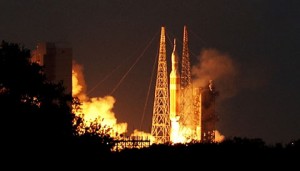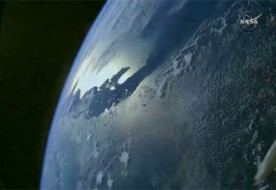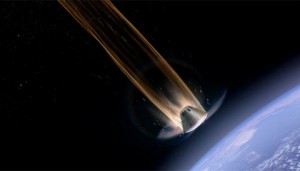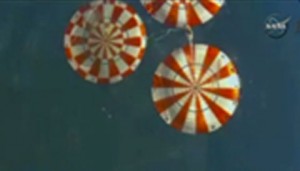On December 5th, NASA successfully launched the first test flight of its Orion capsule. Scheduled to carry astronauts beyond low-Earth orbit in the 2020s, the spacecraft is NASA’s first deep-space people transporter since the Apollo days.
I’m at a major disadvantage when writing about NASA’s manned spaceflight program: I’m not one of the cool kids who remember the Apollo program. In fact, I was born about a third of the way into the Space Shuttle program. So NASA’s Orion missions will be my first real foray into the spacefaring age.

NASA
That foray began on December 5th. At 7:05 a.m. EST (12:05 Universal Time), the Orion capsule launched from the Kennedy Space Center aboard a gargantuan Delta IV Heavy rocket, aiming east across the Atlantic. Gusty winds and finicky fuel valves had delayed the launch from its original December 4th date, but takeoff happened as the launch window opened on Day 2.
Orion is the next generation in manned spaceflight — although this flight wasn’t manned — and is designed to take astronauts beyond low-Earth orbit.
The NASA–Lockheed Martin team intended this test flight to be risky, NASA program manager Mark Geyer said in a prelaunch press conference. Although we’ve sent astronauts beyond low-Earth orbit before, Orion isn’t Apollo and technology has changed since then. For example, today’s computers are much more powerful and will give the crew far more access to onboard systems than in the previous generation. But these computers are also more susceptible to radiation than those of the 1960s, so designers needed to know how Orion’s onboard systems would weather passage through the Van Allen radiation belts girding our planet. (Radiation sensors onboard also measured the doses passengers would be exposed to.)
“We need to make sure it works right, before we put people in it,” Geyer summed up.
Exploration Flight Test 1: To Space and Back

NASA
Orion did two separate orbits in this test flight. First, it inserted into a low-Earth orbit about 17 minutes after launch, reaching an altitude on par with that of the International Space Station. This orbit was highly elliptical, about 115 miles by 550 miles (185 km by 880 km).
Second, 2 hours after launch the Delta IV second stage reignited, pushing Orion out into its higher orbit. Shortly thereafter the spacecraft turned off its flight test cameras to protect them during its 15-minute passage through the peak radiation of the Van Allen belts. (It did this coming back, too.) At 10:11 a.m. EST it reached an altitude of 3,604.2 statute miles, 15 times farther out than the ISS orbits.
This second orbit was crucial for testing the heat shield. Orion can’t get all the way to the Moon on a Delta IV — it needs the under-development Space Launch System (SLS) — but having traveled this far out before turning around and coming home, its reentry speed reached about 20,000 mph (9 km/s), 84% of the reentry speed it would have if returning from a lunar mission. This whizzing arrival created a force of more than 8 g’s on the capsule (Soyuz passengers returning from the ISS experience about 4½ g’s) and heated the shield to 4,000°F (2,200°C). The scalding enabled mission planners to test the composite heat shield and its titanium skeleton and how hot it got inside the capsule.
A series of 11 parachutes helped slow Orion to 20 mph, the final trio of red-and-white chutes each 116 feet wide. The capsule splashed down in the Pacific less than 4½ hours after takeoff, about 270 miles west of Baja California (a piddling 1½ miles off the predicted splashdown point). Zodiacs set out from the USS Anchorage to recover the capsule, with the USNS Salvor assisting.

NASA
All in all, the test flight was so problem-free that Orion made spaceflight look easy. Commenters even noted that there was minimal chatter in mission control during the flight because the team had no hiccups to talk about.
After docking in San Diego and having its data recorders removed — and some plugs from the heat shield — for processing at a Lockheed Martin facility, Orion will board a flatbed truck and make the 2-week journey back to Florida, arriving just in time for Christmas.
Here’s hoping some enterprising soul puts a big red bow on the truck.
Lessons from this launch will inform the next one, slated for 2018. (Originally that was December 2017, but it looks like it might be pushed back a wee bit.). That mission, Exploration Mission 1 (EM-1), will circle the Moon but also won’t carry people. There are a couple of reasons for this delay in manned flight. For one, the next launch will be the first-ever flight of the SLS system, and mission planners don’t want to risk lives on untested technology. For another, they won’t have all the crew systems in place by then.

NASA
The delay until the next launch and adding the crew systems is not technical, but budgetary. But the team doesn’t sound woeful about the wait: Geyer says they’re just happy to be in the budget.
If all goes according to plan, the first manned mission will come in 2021. After that, Orion will hopefully fly on a yearly cadence, although we’ll have to wait and see.
Be sure to check out NASA’s YouTube videos about Orion.
You can also read the press kit for the Orion test flight.
Learn more about the history of spaceflight in Sky & Telescope's SPACE: From Sputnik to Curiosity.
 8
8
Comments
Michael -Cardoza
December 5, 2014 at 2:27 pm
Honestly I don't want to sound unappreciative. However it just seems like we are trying to get back to where we were with Apollo at this point. With all the flux in the administration I don't know if we will ever get a person to Mars or other solar system target in my life time. I would almost rather at this point that money be put into better space telescopes and robotic missions. They seem to be the only type of missions that actually have any type of scientific outcomes. Manned missions take too long to plan and too much money. By the time they get into the planning and testing phases we get a new administration budgets are slashed new priorities are set and then all hope is dashed. At least with robotic missions they seem to be able to fit them in quick enough into one administration and then they at least get launched.
You must be logged in to post a comment.
December 5, 2014 at 2:47 pm
Congrats to NASA and their contractor team for a successful Orion EFT-1 mission! The launch of EFT-1 from SLC-37 continues a string of successful test flights of crewed spacecraft from this launch pad which, by a historical coincidence, is the same one used a half a century ago for the first orbital test flights of Apollo hardware.
http://www.drewexmachina.com/2014/12/05/from-apollo-to-orion-space-launch-complex-37/
You must be logged in to post a comment.
Anthony Barreiro
December 5, 2014 at 3:21 pm
Yes, congratulations to the entire team for this successful test flight. I still think we should invest our collective resources into robotic missions rather than human space flight -- we could send a huge number of robots on very long missions for the same investment of money, time, and expertise it will cost to send a few humans on a relatively short mission with more symbolic than scientific value. But today is a day to celebrate an accomplishment in the real world. If we're going to invest in human space missions, I hope they will be successful.
You must be logged in to post a comment.
Thomas P Wier III
December 5, 2014 at 9:32 pm
Camille,
I am old enough to remember the entire space program. I lived South of Houston and went to high school with all the astron. kids. During that time the nation was wealthy enough to afford the trip to the moon and fight a war in Vietnam which was longer and worse than any of the current wars! It is a shame the nation is so at war with itself that these great efforts are relatively stunted. Exploration by people left an impression remembered by everyone. I remember I was a Sergeant on leave standing in a bar in Silverton, Colorado with other sergeants when we watched Neil Armstrong walk on the moon. Everyone alive then remembers where they were. Your name, Camille, brings another memory. Gordon Coopers daughter was Camille. I called to ask her to the Senior prom but she wasn't sure she could go. I asked, Why? She said her dad would be in earth orbit at that time. After a delay for family consideration we did go to the prom. So I remember that flight as well. Gordon and Camille are both deceased now. The Orion team deserves every congratulation for doing so much, so successfully with so little.
You must be logged in to post a comment.
Phil
December 5, 2014 at 9:50 pm
Camille, you're making me feel old :)) As a high school sophomore, I vividly remember John Glenn's flight aboard Friendship 7 in 1962.
As for the relative expense of robotic vs. manned space flight, men like Colonel Glenn and Admiral Alan Shepard (who I met in person on a few occasions as a college student) inspired me to become a military pilot.
Robotic may be cheaper, but nothing fires the imagination of young people (and taxpayers) like seeing people in space. I can't imagine seeing a robot on the lunar surface and being as excited as I was when I saw images of Lt. Neil Armstrong and Colonel Buzz Aldrin walking around on the moon in 1969.
You must be logged in to post a comment.
p-b
December 7, 2014 at 5:22 pm
A wonderful re-boot to the US space program (I hope). I am somewhat concerned that the many of the media describe Orion as a Mars vehicle, when it is really just a first step to another series of steps that might land eventually humans on Mars. But reporters are generally science-dumb, and go with the sensational sound bite. If most media were capable or interested in thinking it through, would they notice: six people living in the volume of a small SUV for six months or more, with no return capability? NASA could have done more to encourage more sensible headlines.
You must be logged in to post a comment.
Corey Rueckheim
December 8, 2014 at 6:54 pm
I am discouraged by all of the pro-astronomy people that seem to have such a negative opinion about spending money on manned space exploration. I am glad to hear from others who are interested in learning more about our universe through robotic exploration, but I am worried that they are not considering the negative impact of the comments they make.
First of all, if we weren't spending this money on Orion, it seems unlikely that the money would be re-routed to robotic missions, but rather, that NASA's budget would be slashed and the money would go toward some other endeavor altogether. I, for one, am glad to see that the nation's taxpayers are willing to spend money on space exploration and research, and I am very worried that these educated and well-meaning nay-sayers are major contributors to the negative atmosphere that leads to the budget cuts we all worry about. Please, no more negativity!
Second, and far more important, is that only a relatively few of us are truly captivated by the data that comes from robotic missions. Manned missions to other worlds fuel the hungry minds of ordinary people around the globe in a way that robotic missions will never be able to. I was born after Apollo, yet, even in my average, ordinary life, never does a week go by when I don't come across something about the Apollo missions and their legacy. I work in a factory, and I can talk to all of my co-workers about Apollo - all of them have something to say about it. Yet I find that I can talk to very few of them about robotic missions because the vast majority have never heard about any of them.
I have never witnessed a manned mission to another world. I hope I get to! I have an 11-year-old son whom I took him to see the launch of the last Space Shuttle mission in 2011, and I hope to go with him to watch the first manned Orion launch to another world. Please, don't let negativity destroy my hopes!
You must be logged in to post a comment.
Peter Wilson
December 11, 2014 at 9:41 am
Historically, the Apollo program was a key part of the “domino theory:” if the Soviets beat the Americans to the Moon, it would show the superiority of communism, and nations would fall to communism, one-after-another, like dominos. Nothing moves a nation to action like a common enemy. Today‘s enemy, terrorism, will not be defeated with manned space exploration, hence its lukewarm support.
Recall that it was 45,000 years between man’s rafting to Australia and flying there. Looking back over the vast tracks of time it has taken us to get this far, we might show a little more patience moving forwards. If it takes 45,000 years to establish a colony on Mars, so what? Physicists say we have almost 500 million years before the Sun fries the Earth.
You must be logged in to post a comment.
You must be logged in to post a comment.